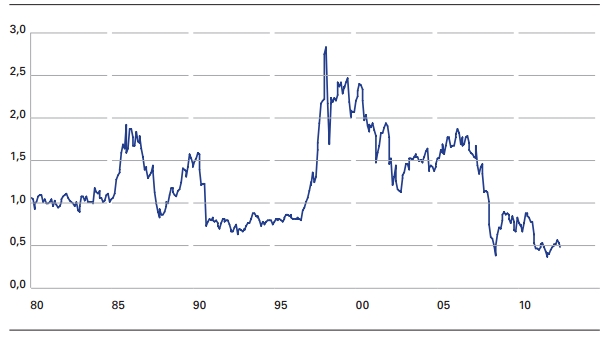Unlike the US, Europe failed to recapitalise its biggest banks following the financial crisis of 2007-09. Instead, policymakers gambled that economic recovery would lift the profitability of financial institutions, enabling them to increase their capital buffers over time. It is now clear that this strategy has failed. The Eurozone is in a new recession and the depressed share prices of many banks signal that they are in dismal health.
On average, the market-to-book value of European banks now is about 0.50 (see Figure 1). This indicates that accountants’ estimates of bank capital are far too rosy, and that banks have substantial hidden losses on their books. In a recent speech Klaas Knot (2013), Dutch central bank president and European Central Bank governing council member, noted that restoration of banks’ balance sheets is a crucial requirement for economic recovery. To facilitate this process, Mr Knot states, it is essential to create transparency about losses in the banking sector and to have an orderly resolution of lossmaking assets. Without this, banks will remain restrictive in making new loans. Mr Knot adds that the planned European banking union offers an appropriate opportunity for speeding up the resolution process.
Figure 1. Price/book value ratio of European banks (monthly data from April 1980 through April 2013)
Source: De Nederlandsche Bank, Overview of Financial Stability in the Netherlands, Spring 2013, Chart 2.
Stress tests and state guarantees
We agree with Mr Knot’s analysis. Unfortunately, an orderly resolution of loss-making bank assets is still a long way off – despite the various bank stress tests conducted in recent years. As reviewed by Hardy and Hesse (2013), these European Banking Authority-sponsored stress tests failed to be credible. They applied stress scenarios that were too mild and enabled banks to get away with insufficiently transparency as to their losses and exposures to problem sectors. Moreover, the European Banking Authority announced recently that it would delay a new stress test until 2014 in order to involve the ECB as part of its envisaged role as the single supervisor for the Eurozone’s largest banks from 2014.
Until now, Europe’s banking sector has been kept afloat by implicit state guarantees of virtually all liabilities. Michiel Bijlsma and Remco Mocking (2013) of the CPB Netherlands Bureau for Economic Policy Analysis find that in 2012 these guarantees provided banks in Europe with an annual average funding advantage amounting to 0.3% of total assets. They base this estimate on a comparison of banks’ diverging credit ratings in scenarios with and without government bailout support. An annual funding advantage of 0.3% of assets can be capitalised to be equivalent to 2% of total assets, on the assumption of a discount rate of 15% commensurate with banks’ uncertain earnings prospects. Given total banking assets of €33 trillion in the Eurozone, we are talking about an implicit guarantee of about €650 billion.
The Cyprus switch
The plight of Europe’s banks worsened considerably when Jeroen Dijsselbloem (2013), Dutch finance minister and Eurogroup president, stated that the approach taken in Cyprus of resolving failed institutions without using taxpayer money would in future preferably apply throughout the Eurozone. Consistent with this, Wolfgang Schäuble (2013), German finance minister, recently stated his desire ‘to ensure that enrolling taxpayers to rescue banks becomes the exception rather than the rule’, and that to achieve this ‘we need credible EU bail-in rules as soon as possible’.
Banks are already saddled with ample unrecognised losses on their assets, estimated by many observers to be at least several hundreds of billions of euros and mirrored by low share price valuations, and an additional loss of their present funding advantage will be crippling.
Financial markets understood Mr Dijsselbloem’s message, as shown by a subsequent decline in the share prices of many institutions. Very low bank valuations imply that they will find it very difficult to recapitalise themselves by issuing equity or debt that is convertible into shares – in part because share issuance would further dilute the value of implicit state guarantees. Low share prices, in effect, imply that banks can raise only limited capital by issuing new shares, and that they may need to accept reduced issuance prices. Very few large European banks are raising capital by issuing new shares, no doubt as they realise that this is not in the interest of current shareholders. As exceptions, Deutsche Bank raised almost €3bn in April, while Commerzbank announced plans to raise €2.5bn through a heavily discounted rights issue in May.
Time to recognise losses
It is now urgent to start recognising losses on balance sheets to avoid a proliferation of Japanese-style zombie banks in Europe. To facilitate this, we advocate conducting a new and thorough stress test soon, similar to the one administered by US supervisory authorities in 2009. Of course, the financial position of most governments in Europe is much worse than that of the US in 2009. So Europe needs to take a path towards recapitalisation that in some respects differs from the earlier US approach.
- First, a credible stress test should assess the losses hidden on the balance sheet for each bank, as well as the likely cost of the removal of implicit guarantees of all liabilities.
This will result in an estimated capital shortage, taking into account capital levels as required by international bank supervisors. Recently, the Financial Services Authority (2013) conducted a stress test of UK banks, resulting in a necessary downward adjustment of reported regulatory capital of about £50 billion, and a resulting regulatory capital shortfall of £25 billion. The estimated capital shortfall of £25 billion is likely to be a low estimate, as it is by and large predicated on the continuation of implicit state guarantees in the UK. At any rate, thorough stress tests in other European countries are likely to reveal sizeable capital shortfalls as well.
- Second, supervisors need to assess whether the capital shortfall can be financed by international capital markets and/or national governments.
In case the required amounts are too high, the bank immediately must be entered into a resolution and restructuring process imposing some losses on unsecured creditors (the Cyprus model).
The legal basis for this resolution and restructuring would be an intervention law, which some European countries may need to enact through emergency legislation. Most banks in Europe, in contrast with their Cyprus counterparts, have significant financing by bond holders and can be recapitalised by imposing losses on holders of subordinated and common debt without infringing on savings deposits.
- Third, in the event that capital shortfalls are relatively small, supervisors could instead implement the US model.
This would mean that banks are given a limited period of time to issue equity on international capital markets, after which national governments step in to provide the remainder of the equity shortfall.
Concluding remarks
The way in which Europe recapitalises its problem banks now has a direct impact on the design of the future European banking union. If many banks are recapitalised by imposing losses on unsecured creditors, such as holders of subordinated and common debt, this is likely to be reflected in the design of the single resolution mechanism that will determine the extent to which bail-ins are mainstreamed in future bank resolutions in the EU.
A single resolution mechanism along these lines will make it easier to reach agreement on the powers of the envisaged future European resolution authority. Last but not least, the adoption of the principle that unsecured creditors should absorb most of the losses of problem banks implies that only limited residual potential losses will be borne by European taxpayers through the European stability mechanism (ESM) and through any future European resolution fund.
Europe has postponed the recapitalisation of its banking sector for far too long. And, without such a recapitalisation, the danger is that economic stagnation will continue for a long period, thereby putting Europe on a course towards Japanese-style inertia and the proliferation of zombie banks.
Editor’s Note: An earlier, less technical version of this article was published as ‘Banish the threat from Europe’s zombie banks’ on the comment page of the Financial Times on May 6, 2013 (see http://www.ft.com).
References
Bijlsma, MJ and RJM Mocking (2013), “The Private Value of Too-Big-to-Fail Subsidies”, CPB Discussion Paper, 240, available at http://www.cpb.nl.
Dijsselbloem, JRVA (2013), “The FT/Reuters Dijsselbloem Interview Transcript”, Financial Times, 26 March, available at http://www.ft.com.
Financial Services Authority (2013), “Methodology Note on Calculating Capital Pressures”, 27 March, available at http://www.bankofengland.co.uk.
Hardy, DC and H Hesse (2013), “The Future of Europe-Wide Stress Testing”, VoxEU.org, 20 April.
Knot, KHW (2013), “ECB-Beleid in de Schuldencrisis” (“ECB Policy in the Debt Crisis”), De Nederlandsche Bank, 28 March.
Schäuble, W (2013), “Banking Union Must Be Built on Firm Foundations”, Financial Times, 12 May, available at http://www.ft.com.



